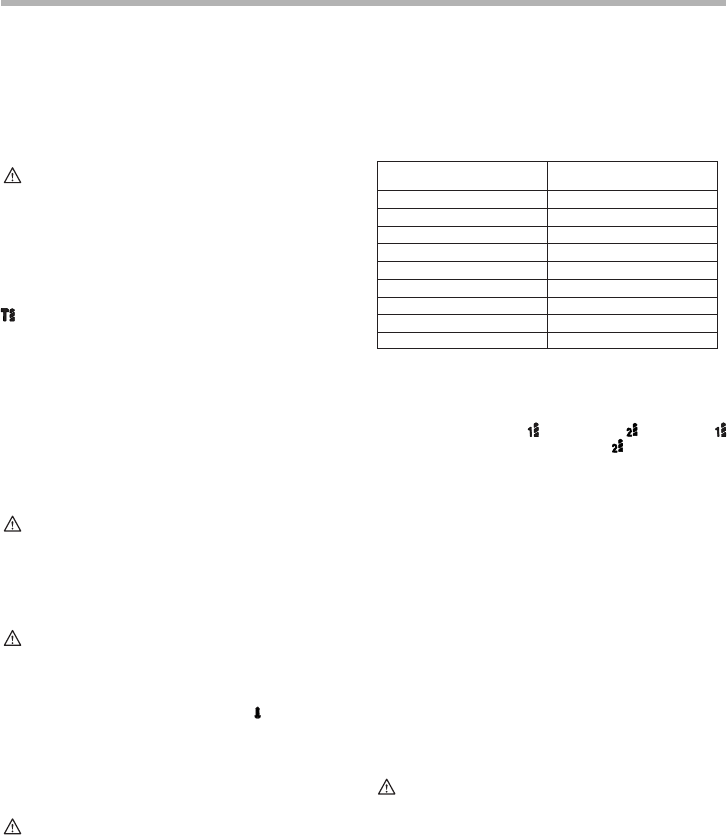
9
4. The manner of holding the tool or the material of
driving position to be fastened will affect the torque.
5. Operating the tool at low speed will cause a reduc-
tion in the fastening torque.
Hammer drilling operation
CAUTION:
• There is a tremendous and sudden twisting force
exerted on the tool/bit at the time of hole break-
through, when the hole becomes clogged with
chips and particles, or when striking reinforcing
rods embedded in the concrete.
To drill in the concrete or tiles, first, turn the action mode
changing lever so that the arrow on the lever points to the
mark on the tool body. The adjusting ring can be
aligned in any torque levels for this operation.
Be sure to use a tungsten-carbide tipped bit.
Position the bit at the desired location for the hole, then
pull the switch trigger. Do not force the tool. Light pres-
sure gives best results. Keep the tool in position and pre-
vent it from slipping away from the hole.
Do not apply more pressure when the hole becomes
clogged with chips or particles. Instead, run the tool at an
idle, then remove the bit partially from the hole. By
repeating this several times, the hole will be cleaned out
and normal drilling may be resumed.
CAUTION:
• If the tool is operated continuously until the battery
cartridge has discharged, allow the tool to rest for
15 minutes before proceeding with a fresh battery.
Screwdriving operation
CAUTION:
• Adjust the adjusting ring to the proper torque level
for your work.
When driving small wood screws or machine screws. set
the action mode changing lever to the mark. Adjust
the adjusting ring to the proper torque level for your work.
Place the point of the driver bit in the screw head and
apply pressure to the tool. Start the tool slowly and then
increase the speed gradually. Release the switch trigger
as soon as the clutch cuts in.
CAUTION:
• Make sure that the driver bit is inserted straight in
the screw head, or the screw and/or bit may be
damaged.
• If the tool is operated continuously until the battery
cartridge has discharged, allow the tool to rest for
15 minutes before proceeding with a fresh battery.
NOTE:
• When driving wood screws, predrill pilot holes to
make driving easier and to prevent splitting of the
workpiece. See the chart.
Drilling operation
First, set the action mode changing lever so that the
pointer points to to the mark or the mark. The
mark is for low speed rotation and the mark is for high.
The adjusting ring can be aligned in any torque levels for
this operation. Then proceed as follows.
Before operation, always make sure that the lever is cor-
rectly set to your desired mode mark and use the tool at
an appropriate speed for your work.
Then proceed as follows.
Drilling in wood
When drilling in wood, the best results are obtained with
wood drills equipped with a guide screw. The guide
screw makes drilling easier by pulling the bit into the
workpiece.
Drilling in metal
To prevent the bit from slipping when starting a hole,
make an indentation with a center-punch and hammer at
the point to be drilled. Place the point of the bit in the
indentation and start drilling.
Use a cutting lubricant when drilling metals. The excep-
tions are iron and brass which should be drilled dry.
CAUTION:
• Pressing excessively on the tool will not speed up
the drilling. In fact, this excessive pressure will only
serve to damage the tip of your bit, decrease the
tool performance and shorten the service life of the
tool.
• There is a tremendous force exerted on the tool/bit
at the time of hole break through. Hold the tool
firmly and exert care when the bit begins to break
through the workpiece.
• A stuck bit can be removed simply by setting the
reversing switch to reverse rotation in order to back
out. However, the tool may back out abruptly if you
do not hold it firmly.
• Always secure small workpieces in a vise or similar
hold-down device.
4.2 - 4.4 (11/64” - 11/64”)
Nominal diameter of wood screw
(mm)
3.1 (1/8”)
3.5 (9/64”)
3.8 (5/32”)
4.5 (11/64”)
4.8 (3/16”)
5.1 (13/64”)
5.5 (7/32”)
5.8 (7/32”)
6.1 (15/64”)
Recommended size of pilot hole
(mm)
2.0 - 2.2 (5/64” - 3/32”)
2.2 - 2.5 (3/32” - 3/32”)
2.5 - 2.8 (3/32” - 7/64”)
2.9 - 3.2 (7/64” - 1/8”)
3.1 - 3.4 (1/8” - 9/64”)
3.3 - 3.6 (1/8” - 9/64”)
3.7 - 3.9 (9/64” - 5/32”)
4.0 - 4.2 (5/32” - 11/64”)
001904


















